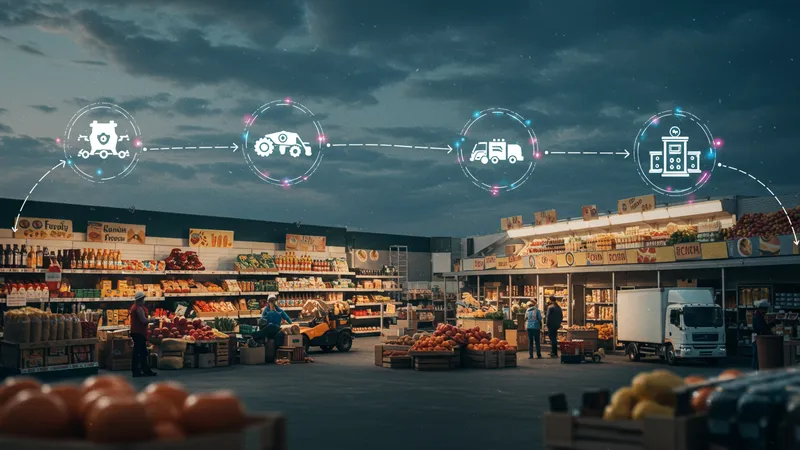

Imagine a world where the secure, transparent, and immutable qualities of distributed ledgers aren’t just confined to digital currencies. The core idea behind blockchain technology is a decentralized data method that allows multiple parties to record, verify, and share information without needing a central authority. As industries seek innovative solutions for data verification, efficiency, and trust, blockchain’s powerful features are now being applied beyond digital coins, transforming the foundations of countless sectors.
Today, businesses worldwide are exploring how blockchain can reshape supply chains, identity management, voting systems, and more. By removing intermediaries and creating audit trails resistant to tampering, blockchain adds new layers of transparency and efficiency to everyday operations. These benefits have driven rapid adoption in areas such as logistics, intellectual property rights, governmental processes, and cross-border trade—all far removed from the realm of crypto-assets.

Take IBM Food Trust as a clear example. It enables producers, suppliers, retailers, and end consumers to trace food items from farm to fork, checking every step along the way for freshness and authenticity. This reduces contamination risks, counterfeit incidents, and costly recalls—giving retailers and shoppers alike reliable transparency.
Everledger approaches blockchain from a very different angle. By recording the full history of diamonds and luxury items on an immutable ledger, it prevents fraud and disputes over ownership. This helps insurers, buyers, and sellers trust in a product’s origin, especially in high-value global markets that demand strict regulation and authenticity.
Meanwhile, Voatz demonstrates blockchain’s reach into civic life. Their mobile voting system lets eligible voters securely cast ballots from anywhere. Every vote is encrypted on the blockchain, providing end-to-end verifiability and potentially boosting voter confidence and accessibility, especially for remote or overseas populations.
The expanding use of blockchain in these fields highlights its potential to disrupt traditional record-keeping, data validation, and trust-based processes. As the technology matures, businesses and organizations continue to explore creative deployments, highlighting more non-financial advantages of distributed ledgers. The deeper details reveal even more valuable insights ahead—unique features, impacts, and challenges in blockchain’s broader journey await discovery on the next page.
Blockchain has revolutionized how supply chains operate, delivering end-to-end traceability previously difficult to achieve. IBM Food Trust provides a clear window into each product’s journey, allowing grocery giants and consumers to verify where, when, and how foods were produced and transported. Every actor in the chain logs transactions into an unalterable system, making it easy to pinpoint sources of contamination or delay, while reassuring buyers that quality standards have been maintained throughout the lifecycle of goods.

Traditional supply chains often suffer from incomplete data flow and limited visibility, resulting in costly waste and potential safety risks. Incorporating a decentralized ledger into logistics means every movement, inspection, or handoff is recorded and verified by multiple parties, creating an auditable trail. For companies committed to sustainability and ethical sourcing, blockchain-based solutions offer the proof required to validate claims around organic certification, fair labor, or eco-friendly logistics.
One real-world impact: when a foodborne illness outbreak occurs, blockchain’s comprehensive records help health officials and suppliers isolate affected batches in minutes, drastically reducing the scope and duration of recalls. In parallel, retailers benefit from reduced losses and improved consumer trust. By boosting accountability, blockchain elevates both food safety and reputation management across global markets.
The scalability of blockchain in supply chain applications continues to evolve. As more organizations participate and connect their data to the same platform, the ecosystem becomes richer and more useful for everyone involved—leading some experts to predict a fully integrated, trusted supply marketplace is just over the horizon. The next page explores how blockchain’s strengths in provenance and authentication shape industries like art and luxury goods, where trust is paramount.
Everledger exemplifies how blockchain can conquer fraud in high-value asset markets. Diamonds, fine wines, artworks, and other luxury items are uniquely vulnerable to misrepresentation or theft. By registering each asset’s full history—including origin, custody, and sale—on a permanent blockchain, Everledger ensures that every stakeholder, from manufacturers and insurers to retailers and collectors, can verify authenticity instantly and without ambiguity.

For the diamond industry, a sector plagued by illicit trading and “blood diamonds,” using blockchain turns due diligence into a streamlined process. Every physical asset receives a digital twin with a unique identifier and transaction log. Insurers, underwriters, and even consumers can consult this ledger, greatly minimizing disputes. This has prompted other luxury industries to follow suit, with applications in fashion, spirits, and rare memorabilia secure in blockchain’s incorruptible records.
Authentication is also vital in today’s globalized art market, where provenance disputes can cripple sales or spark legal battles. Blockchain-led solutions help galleries, auction houses, and buyers eliminate uncertainties, reducing the risks of buying forgeries or mispriced works. As more asset classes are digitized and tracked, the ripple effect is improved market stability and confidence among stakeholders.
The reliability and specificity of blockchain-based authenticity systems pave the way for further innovations, potentially extending to pharmaceuticals, electronics, and collectibles. As these developments unfold, the next section turns to another critical domain—how voting and civic engagement are being transformed by blockchain’s verifiable record-keeping principles.
Securing elections and improving trust in voting mechanisms represent major societal challenges, especially in regions concerned with both accessibility and transparency. Voatz’s blockchain-powered platform offers a viable solution, enabling secure digital voting that’s auditable, tamper-evident, and user-friendly. Ballots cast on Voatz are encrypted and stored as immutable records, ensuring each step of the process—from voter ID verification to final tally—is transparent and independently verifiable.

Mobile voting using blockchain reduces barriers for populations that may struggle to access polling sites—such as overseas citizens, military personnel, or individuals with disabilities. By eliminating intermediaries and delivering real-time audit trails, systems like Voatz can increase turnout and reduce errors or manipulation. The promise lies in bridging the gap between convenience and electoral integrity, though successful rollout depends on robust cybersecurity frameworks and careful regulatory oversight.
Pilot projects in select jurisdictions have demonstrated blockchain’s practicality for low-to-medium scale elections and citizen referendums. While full-scale nationwide implementation will require careful refinement, the transparency, auditability, and user-access offered by blockchain are driving more governments and organizations to explore these systems for future elections and participatory processes.
As trust in digital governance grows, the impact of blockchain on civic engagement could extend well beyond elections. The subsequent page will look at adoption hurdles, standards, and forward-looking integration challenges that must be addressed for blockchain deployments outside cryptocurrency to realize their vast potential.
The rapid adoption of blockchain outside finance brings unique implementation challenges. Interoperability between different blockchain platforms remains a key concern. For example, supply chain players connected to IBM Food Trust may rely on proprietary systems that don’t seamlessly interact with competitors’ solutions. Industry-wide standards and collaborative protocols are now a priority, as broad compatibility dramatically increases the value and utility of blockchain records in complex, multi-party ecosystems.

Scalability and transaction speeds also require consideration. While blockchains deliver unmatched security and auditability, large volumes of data can strain current infrastructure. Solution architects must balance the need for decentralization against system performance, often opting for hybrid or permissioned models to keep costs manageable and workflows efficient. The pricing structures, such as those offered by IBM Food Trust and Everledger, reflect these underlying technical realities and the extent of enterprise customization required.
Education and user adoption are equally critical. Decision-makers, technical teams, and frontline users often face learning curves in deploying blockchain tools effectively. User-friendly interfaces, robust documentation, and ongoing support are essential ingredients for sustained success. Early adopters’ experiences—both their triumphs and obstacles—continue to shape best practices for wider adoption across diverse sectors.
Looking ahead, the intersection of regulatory policy, technical innovation, and market demand will chart blockchain’s trajectory far beyond digital currencies. As industries and governments refine applications for transparency, provenance, and digital governance, blockchain’s evolving capacity promises to reframe the foundations of trust in the digital era.